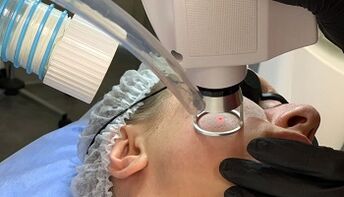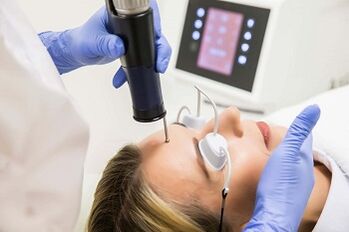
Aging is a natural biological process that affects all tissues of the human body. It is especially vulnerable to the parts of the body that make up a person's appearance.
For example, facial tissues are constantly exposed to environmental factors, as are facial functions, chewing, and speech.
The issue of keeping the face youthful is very important and appropriate, since it is a kind of "lot" of a person.
Today there are many methods to solve this problem, but according to reviews, laser facial rejuvenation deserves special attention.
Mechanism of action of laser on the skin
The essence of this method is the fractional effect of the laser beam on the skin. The laser beam, by splitting into many very thin beams, affects microscopic areas of skin and evaporates them. The areas of impact of the laser are at strictly specified depths. The intact cells, located between the areas exposed to the laser, begin to actively produce two main "building materials" - elastin and collagen, since with age these substances are practically in the human body. no longer formed independently.
After laser facial rejuvenation, skin color is improved, bags under the eyes are removed, small and medium wrinkles disappear or are corrected, facial contours are firmed. In addition, this method is used to improve the results of surgical interventions (for example, in plastic surgery), as well as laser skin resurfacing.
Types of fractional laser facial rejuvenation
Depending on the depth and nature of the penetration of the laser beam into the skin, there are two types of procedures:
- Ablative fractional laser skin rejuvenation, where microscopic areas of skin are removed and then, during the healing process, the damaged areas are tightened. The lifting effect is noted after the first procedure;
- Non-ablative facial rejuvenation, when collagen and elastin are also regenerated in the damaged area, but this process takes place in the deep layers of the skin, allowing the laser to penetrate without damaging the outer layers. As a result of this procedure, the rejuvenation process lasts longer.
Optimal variations of this technique can be suggested by a specialist, but according to reviews, with laser facial rejuvenation, it is most effective to combine different types of procedures for the rejuvenation process. Cell generation takes place not only on the surface of the skin but also in the deeper layers.
Benefits of Fractional Laser Facial Rejuvenation
Fractional laser skin rejuvenation, compared with the classical method, has several advantages.
Firstly, the effect on the skin is precise, which means that its harm is minimal. Thanks to this, all traces of the procedure disappear in 3-4 days after the intervention.
Secondly, in one treatment large areas of skin can be treated, while its regenerative resources are not only preserved, but also activated, ensuring a quick recovery and a positive effect. Castle.
Third, the procedure does not require anesthesia and can be easily performed on the skin in the eye, neck and eye area.
And fourth, side effects are rare. Complications can occur in the form of red bumps in the action area, mild itching, peeling, burning or scabs on the skin that quickly disappear. Scarring, hypopigmentation and hyperpigmentation are extremely rare.
Despite the listed advantages, before performing the procedure it is necessary to familiarize yourself with the indications and contraindications of laser facial rejuvenation.
Indications for laser rejuvenation
During its existence, this method has proven its effectiveness, but its effect will be especially noticeable in the case of the following skin problems:
- Spider tendons;
- Scars;
- Stretch marks;
- Enlarged pores;
- Skin pigmentation;
- Acne;
- Wrinkle;
- Loose, sagging, fading skin;
- Crow's feet around the eyes.
If any of the problems on the proposed list are relevant, fractional laser facial rejuvenation will help solve that problem.
Contraindications for laser facial rejuvenation
In addition to the obvious indications, there are also absolute contraindications to the procedure:
- Inflammatory process in the affected area;
- Dermatology and psoriasis;
- Tends to form tumor-like scars;
- Herpes in the affected area;
- Cases of vitiligo in close relatives;
- Chemical peels performed less than 2 weeks before the proposed procedure;
- Systemic diseases of the blood;
- Varicose veins in the area of the laser;
- Pregnancy and lactation;
- Cancer;
- Severe forms of coronary heart disease and hypertension.
A relative contraindication to laser facial rejuvenation is the appearance of tanned, medium, and freshly peeled skin less than 3 weeks before the procedure.
Laser rejuvenation therapy and subsequent actions

Depending on the area of skin being treated and the nature of the problem, the duration of a fractional laser session is from 20 to 40 minutes. The repeat procedure is possible only after 3 or 4 weeks, and in total, as a rule, 3-4 sessions are required. Within three months after completing the course, the maximum positive effect is observed. To maintain it, it is recommended to have repeat sessions once a year.
You may feel a slight burning sensation after the procedure, but this should go away in about 1-2 hours. The result is redness and possibly mild swelling that lasts for 1-3 days. At this time, it is recommended to use external agents containing depanthenol (for example, ointment or gel). As soon as the listed symptoms disappear, it is necessary to use a cream containing hyaluronic acid.
You can wash and shower the same day of laser facial rejuvenation, but it's better to postpone going to the pool or sauna. One day after the treatment, you can use the foundation again.
The use of sunscreen with an SPF of 30 or higher is mandatory, as the skin is especially sensitive to UV rays at this time.
After laser vaginal rejuvenation, you should follow the recommendations of the specialist performing. Depending on the type and characteristics of the skin, the doctor will recommend optimal cosmetic preparations, as well as determine the frequency and duration of their use.


























